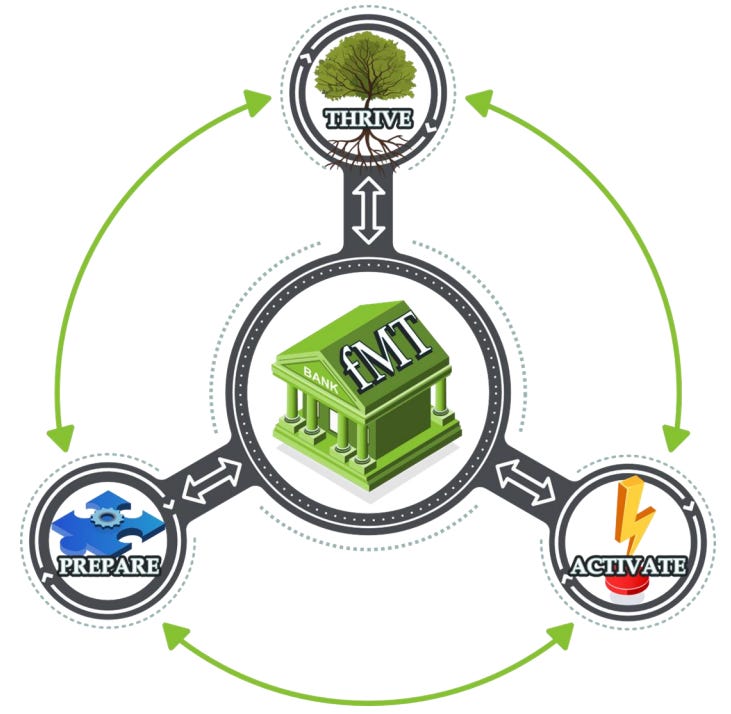Shifting the Algorithm
We don't have to accept "All Things Being Equal"
One of the central tenets of Not Done Yet! is our ability to resist the "all things being equal" status quo. You've likely heard the population data: we lose, on average, 1% of our muscle mass (often translated to include strength, speed, performance and function) per year after the age of 40. As highlighted in this previous article, most focus on the initial statement about the 1%/year losses, but very few remember the words that follow: "all things being equal." That's where our opportunity exists. We are not required to follow the crowd. We don't have to sit back and passively accept the 1%/year degradation. There is a better path forward.
But what is that alternative path? HOW do we go about shifting the natural algorithm from the typical 1% annual drop to neutral? Or perhaps it's even possible to initiate an upward trend? What options are available to those of us who are ready to lean in and move forward in a positive direction? That's exactly the focus over the next few minutes.
Catalyst Cornerstones
Everyone is looking for the hack, the shortcut, the magical supplement, the perfect fitness routine. All the while, the true gold is hiding in plain sight, while the glitter garners the attention. Before we take a deeper dive, take a moment to seriously consider the role of the Catalyst Cornerstones (Move, Fuel, Rest & Connect) in your current rhythm of life. I'll return to these - likely repeatedly due to their importance in the bolstering of life's 2nd half - in future articles. For now, rather than brushing them off as old news, honestly reflect on the current status of each in your life, as one or more may provide low hanging fruit to more than cover our 1% annual boost target.
Move - Think back to your activity level a decade or two ago and compare to today. "Move it or lose it" isn't just a catchy phrase - it's our reality. Perhaps before tackling the higher level options highlighted below, an initial goal simply involves more movement!
Fuel - We use this word (vs. "eat" or "food") for the obvious reason that it reminds us of the primary purpose of what we put in our mouths: to fuel optimal performance. Over time, the slow fade can create habits with empty calories (both food & drink) along with deficits in key nutrients. Is there an opportunity here to positively impact that 1% deficit you're seeking?
Rest - Sleep impacts our cognition, energy, relationships, testosterone, response to exercise, food choices and more. It IS the straw that stirs the drink of optimal living, and yet we often toss it aside like an old shirt in favor of (seemingly) more exciting alternatives. If there's such a thing as magic, sleep is that thing. EASY 1% boost here if not currently on track.
Connect - Our connections with others significantly impacts all aspects of life, including the other 3 Cornerstones. Relationships matter - do yours?
Tier II Options
Once the Cornerstones are addressed, we can move onto Tier II Options. These are adjustments that involve a bit more commitment on our part, but still apply to the majority of the population. In contrast, the Mastery Pursuits that follow are generally reserved for those looking to perform at the very highest levels physically and, as such, likely only apply to a small percentage of the population.
Strength Training - If the studies indicate we lose 1% of our muscle mass/year after the age of 40, what is the obvious solution? Right. If you've been consistently engaging in strength training throughout your life, then you may want to consider adding a little extra time to your routine. However, for MOST of us, we simply need to START strength training. What was once a bonus becomes essential in the 2nd half of life. There are endless options to integrate this into our lives, but the activity itself? Not an option if we care about shifting the algorithm. By the way, if you hear any little voices telling you it’s too late to start, feel free to share this recent study with them. It demonstrated not just a maintenance but an improvement in strength and lean mass in those over 85 years of age!
Alcohol intake - There is a time and a place for those who enjoy a drink. It's important to remember that while the primary purpose of food is fuel, it's also community. As such, the recommendation here isn't to eliminate alcohol from your life but rather to choose it purposefully. We know it's empty calories (and is usually accompanied by empty calorie foods), reduces the quality of our sleep, influences testosterone levels, muffles the frontal lobe in ways that can have negative outcomes and negatively affects the body’s systems in various ways, as noted in this published systematic review. Personally, I avoid alcohol leading up to a race, big training session, or other important life event/pursuit, but may enjoy at other times (link to video on my personal 30-day challenge). As a sidenote, there are a growing number of tasty non-alcoholic alternatives (with none of the downsides) that might be worth a try.
Creatine - Once upon a time, creatine was reserved for gym rats seeking legal options to build their biceps. Thanks to an ever growing number of studies, we now know it is beneficial not only in tandem with strength training (see above), sarcopenia, and reduced fall risk but likely also provides cognitive benefits. This recent study from Nature even showed a single dose of creatine enhanced cognitive function during sleep deprivation. For most of the population in the 2nd half of life, daily creatine is a no-brainer (or more accurately, a mo-brainer!). Wendi Irlbeck’s interview on the benefits of creatine is one of the all-time most popular episodes of The Coaching Lab podcast.
Protein - The Recommended Daily Allowance for protein is .8 grams/kilogram of bodyweight/day. Those, like Professor Stuart Phillips, who have spent careers studying optimal levels put this figure 50-100% higher, recommending 1.2-1.6 grams/kg (overview research study here, interview with Dr. Phillips here and brief overview video available here). Bottom line: for the majority of the population and especially those in the 2nd half of life, we benefit from additional and consistent high quality protein sources in our daily lives.
Mastery Pursuits
There are almost unlimited final tweaks available to consider. The following options focus on practical aspects of the four I have personally found to be the most valuable. Your specific outcome goals will drive the specific application of these and complementary elements.
Targeted (vs. generic) supplementation - While the evidence supporting the integration of creatine and protein noted above for most of us, they are outliers. Most supplements highlighted by friends, social media influencers and the popular press are simply increasing the cost of our urine. Targeted supplements - based on our own blood test results - are the exception. Personally, I do a deep dive blood test annually (covering far greater depth than the standard blood test) and review with physician board certified in lifestyle medicine to determine whether a personal (not generic, population-centric) gap may benefit from adding a supplement.
Intervals - As a masters athlete approaching 60, I regularly hear peers complaining about lost speed or a drop-off in pace. Clearly, a trained athlete at 60 is not going to be as fast as one in their 20's. However, such drop-off is not a cliff but rather a combination of time, habit shifts, and potentially bodyweight differences from prior years (brief video overview here). Appropriate interval sessions, or speed work - applied with a dose of wisdom - can often be the missing link. When I was looking to break 5 minutes in the mile at age 50 after years of triathlon focus, it involved significantly more speed work. But doing so produced results, and within 6 months, I was running under 5 min (4:54). Yes - age had influenced my speed, but the bigger influence was lack of interval training, and the research clearly backs this up. The wisdom piece is how we integrate this, not suddenly, but gradually over time. If speed work is new to your routine, consider beginning by simply picking up your pace in the middle of a run for 60-90 seconds and build from there. Bonus tip - there are a growing number of running clubs that combine community with weekly speed training that are definitely worth considering.
Plyometrics & Power - Similar to speed work, plyometrics and power tend to be gaps for most of us in 2nd half of life. One recent study in the Journal of Applied Physiology highlighted by Dr. Alex Hutchinson showed a degradation in power measuring 2-4 times that of our muscle loss with aging and we discussed the importance with orthopedic surgeon Dr. HJ Luks on this episode of The Coaching Lab. Gradually and wisely integrating power and plyometric activities into your weekly routine will have a noticeable impact on this otherwise rapidly expanding gap. Some of my personal favorites include jumping rope, heavy bag work, and box jumps.
Functional Mental Toughness - The mental side of life plays an immense role in both the way we implement the above and various complementary aspects of our days.
My PhD work focused on developing the fMT (functional mental toughness) model for living. We'll return to the subject in the future, but here's a simple example of how one might utilize a singular element on race day (but can be applied to any aspect of life) — Within the Prepare phase of the fMT Model, advanced planning allows us to avoid making withdrawals from the bank for non-critical aspects, thus saving it for something more important. For example, if you're running a half marathon Saturday, your goal is to be able to turn off your brain beginning Friday afternoon. Eliminate the need for an fMT withdrawal related to what or when you'll eat, where you'll park, time you'll leave, which clothes you'll wear, etc. By pre-scripting logistics, you keep your fMT Bank available for more important withdrawals at critical periods (e.g., mile 10) rather than wasting it on something like parking logistics. This same strategy can be applied to almost any setting for which you desire to maximize your available fMT. We’ve provided additional details for those interested in these brief, freely available videos.
The status quo, like the gates of hell from Virgil's Aeneid "are open night and day; Smooth the decent, and easy is the way. But to return, and view the cheerful skies, in this the task and mighty labor lies."
Look around. Most of our 2nd half of life peers have (consciously or unconsciously) decided to settle. But the status quo, like the gates of hell from Virgil's Aeneid "are open night and day; Smooth the decent, and easy is the way. But to return, and view the cheerful skies, in this the task and mighty labor lies."
The skies await, my friends. The little-known secret is we discover the cheerful skies of life in the task, rather than in spite of it. I'm not done yet. How about you?





I think there is a beauty in becoming a differently young athlete, which is the capability to understand what you are writing and putting into practice more efficiently.
Thanks for the extensive article! Inspiring and motivating
I like “Rest.”
I also like “Restore” or “Recovery.” They are versatile concepts. They include Rest / Sleep and also concepts such as restoration of glycogen after a workout, restoration of ANS balance after a high sympathetic nervous system stimulus, Recovery days in the microcycle of training, Recovery during the off-season, Recovery in an interval session, etc. Recovery also can be thought of as Preparation, because it is in Recovery days that adaptations (anabolism) takes place